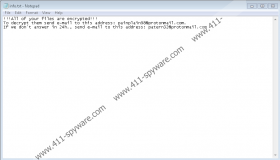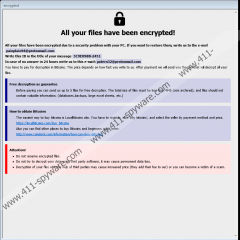Calix Ransomware Removal Guide
Can you protect your Windows operating system against Calix Ransomware? That shouldn’t be hard to do because the infection cannot just appear out of nowhere. You have to let it in, and if you learn about the methods that cybercriminals are using to spread this ransomware, you should be able to protect yourself. First and foremost, we want to remind you how important implementing legitimate anti-malware software is. If your operating system is protected, even if you are tricked into letting malware in, it should be stopped and removed before anything bad happens. If you do not secure your system, you have to be extra cautious about what websites you visit, what files you download and execute, and what spam emails you open and interact with. It is also crucial to note that all updates need to be installed timely. If you skip any, exposed vulnerabilities could be exploited. Hopefully, you have time to secure your system, but if you already need to delete Calix Ransomware, we would love to help you.
Did you first learn about the invasion of Calix Ransomware when a window entitled “encrypted” showed up on your screen? A file named “info.hta” launches this window, and according to our researchers, it should be found on the Desktop and in the %HOMEDRIVE% directory. When the window is launched, you are informed that your files were encrypted. The message also informs that if you want to get your files back, you need to contact the attackers. The first address you are introduced to is painplain98@protonmail.com, but it is stated that you can also use patern32@protonmail.com if you do not get a response within 24 hours after emailing the first address. The message alludes to a ransom payment in Bitcoin, but it does not go into detail, and it is unclear how much you are meant to pay or how you are meant to pay it at all. The second file dropped by Calix Ransomware is called “info.txt,” and it also asks to send messages to either of the two email addresses. Do not do this, unless you want your inbox to be flooded with scam and spam emails.
If you email the attackers behind Calix Ransomware, they will push you to pay a ransom in return for a decryptor. They will promise you to assist you as soon as the money is in their pockets, but do they need to assist you? They do not. The transaction is likely to be anonymous, and so you will not be able to get your money back, and no one will be able to police the attackers and make them fulfill their promises. That is exactly what the victims of Eight Ransomware, Blend Ransomware, and other Phobos Ransomware variants had to deal with. All of these infections are practically identical, and the only thing that changes is the extension that is added to the corrupted files. When Calix Ransomware encrypts your personal files, you should find the “.id[unique ID code].[painplain98@protonmail.com].calix” extension appended to all corrupted files. You might think that the extension will be removed and your personal files will become readable again as soon as you pay the ransom, but that will not happen.
The awful thing about ransomware is that while it is not that difficult to remove, it can leave lasting effects. If Calix Ransomware has corrupted your personal files, they are likely to remain encrypted regardless of what you do or what kinds of instructions you follow. This is why we keep on droning about the importance of backups. Do you have copies of your personal files stored on online cloud systems or external drives? Hopefully, you do because that will mean it is possible for you to replace the corrupted files. If you do not have backups/copies, you are out of options. In either case, it is crucial that you remove Calix Ransomware from your operating system. If you are sure that you can identify the .exe file that launched the infection, you might be able to follow the instructions below. If you are not sure you can handle the manual removal of this infection, we advise installing anti-malware software. It will not only automatically eliminate every single malware component but will also secure it to keep malware away in the future.
How to delete Calix Ransomware
- Delete recently downloaded suspicious files.
- Delete the ransom note files named info.hta and info.txt from the Desktop.
- Tap Win+E keys to access File Explorer and enter %HOMEDRIVE% into the field at the top.
- Delete the ransom note file named Info.hta.
- Enter these lines into File Explorer and then Delete a malicious {unknown name}.exefile:
- %LOCALAPPDATA%
- %APPDATA%\Microsoft\Windows\Start Menu\Programs\Startup\
- %ALLUSERSPROFILE%\Microsoft\Windows\Start Menu\Programs\Startup\
- %ALLUSERSPROFILE%\Application Data\Microsoft\Windows\Start Menu\Programs\Startup\
- Tap Win+R keys to access Run and enter regedit into the dialog box to access Registry Editor.
- Go to HKEY_LOCAL_MACHINE\SOFTWARE\Microsoft\Windows\CurrentVersion\Run.
- Delete the {unknown name} value linked to the {unknown name}.exe ransomware file.
- Go to HKEY_CURRENT_USER\SOFTWARE\Microsoft\Windows\CurrentVersion\Run.
- Delete the {unknown name} value linked to the {unknown name}.exe ransomware file.
- Exit Registry Editor and then Empty Recycle Bin.
- Install a trusted malware scanner to scan your operating system and check for malware leftovers.
Calix Ransomware Screenshots:



